| « The Company Men, The Way Back, Barney's Version, William S. Burroughs: A Man Within & Great Directors | Wildclaw Theater's Carmilla Steams up the DCA's Storefront Theater » |
Feature Fri Jan 21 2011
Strike a Pose: Chicago's Thriving Underground Ball Scene
This story was submitted by Rachel Rabbit White. All photos by Edmund X. White.
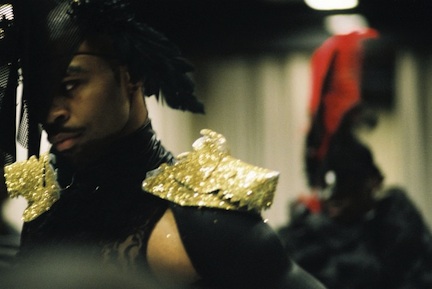
It's a snowy December night on the South Side and the ballroom has filled up quickly. There are guys in tailored suits, girls in red-heeled Louboutins. There are pop-gothy capes and futuristic glasses. The crowd is gathered around a catwalk -- and everyone is young, black and queer.
This is a ball. An underground LGBTQ contest where participants compete by "walking" -- showing off themed outfits and voguing -- a stylized house dance that continues to evolve. They are competing for trophies and the hope to become "legendary" -- famous not only in Chicago but the entire community, which now spans the globe. Balls found fame with Paris is Burning, a documentary about the New York scene, but Chicago's had its own ball circuit for as long as New York -- one that has its own trends, culture and history. And as the Internet popularizes the community, Chicago is seeing another wave in the resurgence of balls.
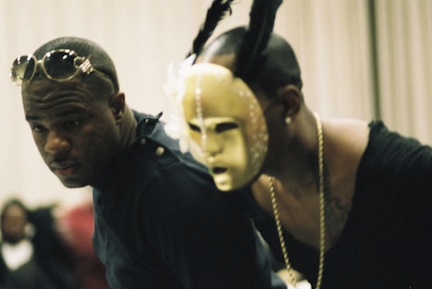
Chicago's underground drag balls came into their own during the 1920s and '30s Harlem Renaissance. Aaron Enigma, a Chicago ballroom figure who has risen to the level of Icon in the community -- other honorifics include Star (a rising talent) and Legend (a veteran winner) -- has been researching ball history for years.
"Chicago had balls with a drag presence before New York," insists Aaron. "We had the First Ward Balls of the Levee District in the early 1900s at the Coliseum. New York just eventually threw the events in more lavish settings."
While New York's old school balls were upper class affairs, Chicago's balls were always more working class.
"Because of Chicago's history of segregation, the old school balls were relegated to the working-class black neighborhoods," Aaron says. "But they still provided a place for non-blacks and gays to mingle." This was during a time when most public spaces were segregated, so balls were some of the only sanctioned spaces. "The Harlem Renaissance was partly about adventurous Whites rubbing elbows with the black arts community on their grounds," he adds.
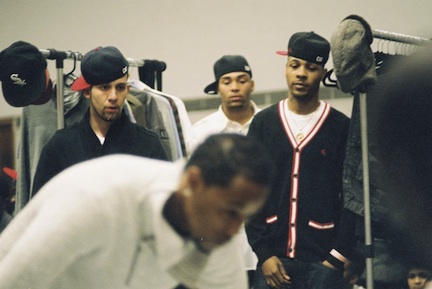
Tonight the ballroom looks a little different. The inter-racial mingling has quieted, with an audience that's about 97 percentblack. Balls are also no longer all about drag queens, with many "butch" categories. The butch-queens (simply gay males, not drag queens or trans women) were the switch from old style balls to the voguing balls today.
"Butch queens changed the balls because they forced them to expand beyond categories for just cross-dressers. So categories were created for a wide range of masculine 'drag': military, urban, collegiate and categories for male beauty," says Aaron.
It's also all about the dancing. Chicago is known as the voguing capitol of the Midwest. At the Escada ball there are vogue femme dancers, incorporating more fluid movements and ballet and modern dance, and some vogue dramatics with more complex tricks.
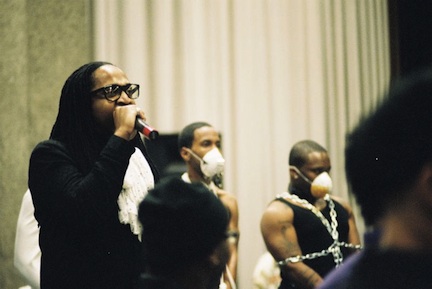
And the competition is ferocious. Grade Fs are flipped easily from the judges table. A dancer doesn't need to just be spectacular, but adhere perfectly to the rules of the category. The wrong color in your outfit and you are out -- chopped! Ball Houses are necessary for competition. At the December Ball, the crowd chanted their house name in time with the DJ. When one of their members walked, the room filled with "E-vis-u, E-vis-u." This way the judges know if someone from their house is walking -- no one denies nepotism has its place.
Twenty-five years ago the first Chicago-ball-house was formed: The House of Avant Garde. "A house is about competition, but firstly it is a group of individuals who come together and consider themselves a family." says Eric Eminence, a Chicago legend. "Usually there is a mother and father-figure and the rest are considered children. It's an alternative lifestyle family who you can talk to and confide in, who can understand the things you're going through. The parents, whom are typically older, give advice and guidance on being gay."
Today, Youtube is filled with ball videos and hundreds of comments -- undeniably the reason the scene is growing. This makes it easier for kids to discover the ballroom community and keep current with how everyone is voguing. "When Avant Garde began, VHS videos from New York is all we had to go on. We lived and breathed these 30 second clips." says Kenny Omni, an icon and the overall "father," or leader, of the House of Omni. Aaron agrees "It involved a lot of videotape trading and the occasional east coast visitor that revealed that they were a voguer in a club setting."
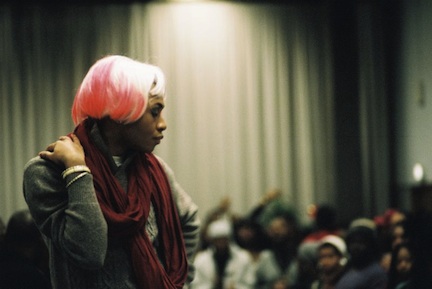
Without the network of the Internet, the ball kids were more alienated, even in their own communities. "Chicago had more rigid ideas about gender roles than New York, even within the gay community," Aaron explains. "This would result in everything from hiding the fact that you were a voguer from potential dates to having drinks spilled on you accidentally-on-purpose at dance clubs. People did not want to accept voguing until Madonna popularized it, and when she lost interest, the general attitude was, 'Why are you still voguing?' Madonna had managed to showcase the dance and trivialize it in one swell swoop."
The House of Avant Garde were voguing (before Madonna) and battling each other, but didn't have their first ball until 1991. This was when they met the late Willy Ninja, a would-be famous choreographer and subject from Paris is Burning. "We did a photoshoot with Willy. We took him out the club, he showed us how to get kids together," says Kenny. At the same time, Chicago house music was coming into its own, forming how Chicago vogued. Chicago also had its own fashion. "Because of Medusa's (Chicago's once under-age Industrial club) goth was the thing in Chicago -- long black coats, riding boots, black turtlenecks," Kenny says. The focus though, as always, was high fashion. Eric adds, "I wore designer clothes: Gucci, Prada, Hermes, Com Des Garcon, Jean Paul Gaultier, Chanel, Dolce & Gabanna, Vivienne Westwood. I walked the 'Labels' category. I had an image to uphold."
Like in so many scenes, the old school waxes nostalgic about how things were better in the beginning, more peaceful. "Back then, we were fighting a battle against the heterosexual community. Now we are fighting amongst our own group of people," says Kenny. "We didn't take the scene as serious as the kids take it now. We looked out for each other, even if we weren't in the same house. We would be able to go to the clubs together. We would go to each others houses to eat."
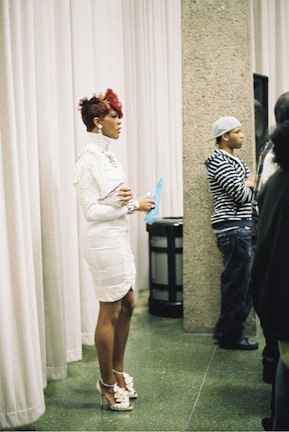
Another side-effect of the Internet is that the competition doesn't stop after a ball, it continues online. "You can blast someone easier from behind a screen name. And if you don't have anything else going on in your life you can lose yourself in the competition," says Will Omni, another father of the Avant Garde house.
Violence at balls has become a much-discussed problem in the community.
But this severe competitiveness is what Kenny calls a Chicago-specific trait. It's the Second City syndrome. "Chicago feels like they need to prove themselves. We need to show we are as good as New York. How kids choose to display that competitiveness is what matters. I like to see Chicago kids use their creative minds." Chicago legend Solomon Infiniti is infamous for this. Kenny re-tells stories of Solomon coming out on the runway in caskets, with doves flying out from his cape and how he once walked in a dress made entirely out of Popeye's chicken boxes. "Right after 9/11 Solomon walked. He re-created the twin towers and came out of them. Like blew them up and everything -- popping out."
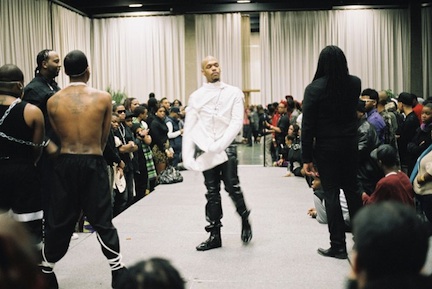
At the December ball the categories are endless. For "thug realness" the boys are transformed into drug dealers riding the Blue Line at late hours of the night. Oiled up muscled bodies are trotted out for a body contest and executive realness brings guys in suits and alligator brief cases. The femme-queens in between are showstoppers in floor length gowns.
"They pay to get outfits made. You have to buy the fabric, pay the designer. It is expensive," says Will. Some of the spectators not only brought out their best outfits for the ball, they flew in for it. "For a lot of kids it's about how do I get what I am wearing to the next ball; how can I travel to that ball. The Internet feeds this. If you don't have the money, you can only get things one way -- stealing." Stealing or "crafting" has been an issue since the beginning of Chicago balls. It's one of the things that comes up again and again, along with HIV and kids being kicked out of their homes for being gay.
"It's hard watching generation after generation of ball kids... I hate to say... destroy themselves. But every year with the new set of ball kids we are faced with this question," says Kenny. "Homeless gay youth were a big problem when Paris is Burning came out and its a big problem now," adds Will. "Maybe even more so because these kids are coming out younger and younger. These kids are sleeping on trains. They can only make money through drugs or prostitution." The House of Omni tries to give the kids a place to stay, but can't offer much beyond crashing at Kenny's apartment temporarily.
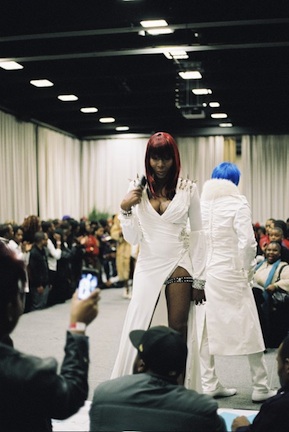
When Paris is Burning focused on this issue, they got flack from the community. "Homeless youth is not a product of the ballroom community. Society at large needs to address this issue. People from within the ball community must take skills honed in the ball setting and apply them to the real world," prescribes Aaron.
The kids looking for a place to belong keep coming to the ballroom. A young member of The House of Omni stumbles into Kenny's living room, and offers some insight. "Gay youth seek the ball scene as a safe haven. When they are finding out they are gay, they'll go to someone in their community, someone at school or in their family, who they may have heard is gay. Then they will be directed to the ball scene."
Kenny and Will agree that the ball community is not accepted in the black community at large, however it seems it hasn't always been this way. Back in the '30s and '40s the Chicago balls thrown by Alfred Finnie were regularly covered in magazines like Jet and Ebony. The black community, it seemed, was proud of their ballroom stars.
According to Aaron, this changed decades later. "The Black Power Movement was divided on whether to combine forces or sever ties with gays in the struggle for civil rights," he explains. "It was feared that the association with gays would hinder advancement. Black gays were also being pressured to choose their allegiance-- color vs. sexual orientation. Then, the emergence of AIDS drove a deeper wedge. But in general, the black community is not as homophobic as it is historically portrayed in the media. Almost everyone knows or is related to someone who is gay. That focus has come from the black church's stance on homosexuality."
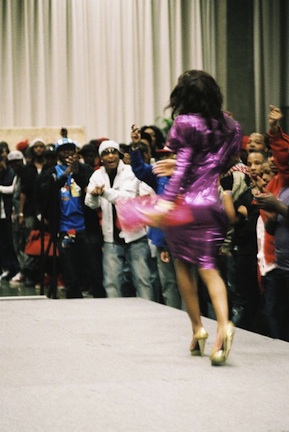
The ballroom scene continues to thrive, albeit underground, on a word-of-mouth basis. "You won't find it on Facebook, because about 40 percent of kids at balls are not out," says Kenny. Eric agrees. "Nowadays, it's easier to hide in a homo thug environment." It's rare that an underground scene so complex, so vibrant could remain shadowed for so long.
"Acceptance by anyone outside the ball community is mute," says Aaron. "As the overall societal attitudes towards the GLBTQ community evolve and ballroom veterans export their talents to the world at large, the level of interest in the ball community will ebb and flow."
It's hard to imagine how a scene without real names, with members who can't tell their friends and family about it, can continue to grow. But balls keep popping up all over the Midwest -- in Indiana, St. Louis, Ohio and Kentucky. The next Chicago ball everyone is abuzz about is in March; it's a best-of-the-year for the 40 major balls held in 2010 across the Midwest. There is now about a ball a month in Chicago and more and more kids keep getting turned on to the movement. Chicago's ballroom scene would do best to forget about competing with New York, and own being the destination for a majority of the country -- the place where all of the ball kids nearby look for inspiration and direction.
This feature is supported in part by a Community News Matters grant from The Chicago Community Trust and the John S. and James L. Knight Foundation. More information here.









Aaron Enigma / January 23, 2011 12:56 PM
Thanks Rachel for including me in this project! I need to add a small correction to one of my quotes- The First Ward Balls were from the EARLY 1900s. It was my error. Thanks!